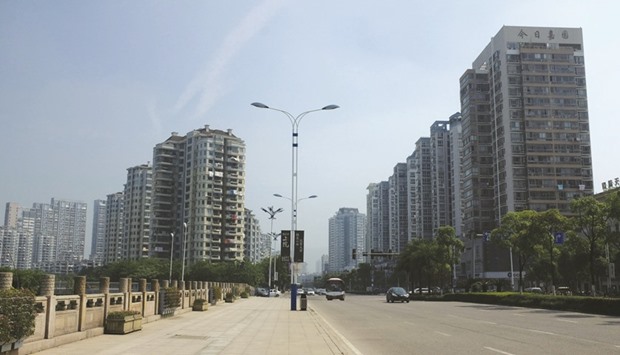China’s home prices rose at a faster pace in May, supported by quicker growth in second-tier cities and a broader recovery in smaller cities.
The recovery in China’s property market since late last year has been a rare bright spot in the world’s second-largest economy, which has been slowing amid weak demand at home and abroad, cooling investment and excess industrial capacity.
But eye-popping home price rises in the biggest cities have raised fears of overheating, and growing debt levels are adding to worries for policymakers and risks for banks.
Average new home prices in 70 major cities climbed 6.9% last month from a year ago, accelerating from April’s 6.2% rise, according to Reuters calculations based on data from the National Statistics Bureau (NBS) yesterday.
The NBS data showed 50 of 70 major cities tracked by the NBS saw year-on-year price gains, up from 46 in April.
“The average growth of new homes in first-tier cities started to narrow, while it continued to widen in second- and third-tier,” Liu Jianwei, a senior statistician at the NBS, said in a statement accompanying the data.
The southern city of Shenzhen remained the top performer, with prices surging 53.2% from a year earlier, slower than the 62.4% rise in April.
On a month-on-month basis, however, prices in Shenzhen were up just 0.5%, slowing from a rise of 2.3% in the previous month and evidence that property cooling measures introduced in some big cities recently are starting to bite.
Shenzhen and Shanghai have tightened downpayment requirements for second homes and raised the eligibility bar for non-residents to purchase properties.
Shanghai prices rose 27.7% on-year, slightly slowing from 28% in April.
Month-on-month gains cooled to 1.9% from 3.1% in April.
While that cooling trend may be good news for policymakers in Beijing, the survey showed sharp price rises are now spreading to other parts of the country.
The coastal city of Xiamen surpassed the top-tier cities and saw the second highest price rise of 28%. Prices in second-tier cities Nanjing and Hefei also rose over 20%, more than the 19.5% seen in Beijing.
“But the expectation is prices in Shenzhen will keep on increasing.
Those who can’t afford it go to neighbouring cities such as Zhongshan, Dongguan and Huizhou, driving up their prices also,” said Andy Lin, market research director of realtor Hopefluent, citing potential price growth in those cities of 30% to 40%.
The spillover of higher prices to major second-tier cities is fuelling speculation that local governments there may also tighten restrictions on home purchases soon to keep housing affordable.
The government of Tongzhou, the eastern suburban district of Beijing, tightened rules last week on purchases of second homes.
Despite signs of a broadening recovery, many small cities still have a large glut of unsold homes.
The polarisation of the housing market is making policymakers’ job harder as they look to support a faltering economy without inflating bubbles.
Investment growth in Chinese real estate slowed in May for the first time since December on a year-on-year basis as tightening measures in big cities took their toll.
China’s housing market is a crucial engine of growth, accounting for around 15% of gross domestic product.
Authorities are hoping a healthier property market will help support growth, even as the broader economy continues to decelerate.
Growth in China’s fixed-asset investment slipped below 10% for the first time since 2000 in January-May as a boost from record credit growth seemed to be quickly fading, putting expectations of further stimulus back on the table.

Residential buildings in Wenzhou, Zhejiang province. Average new home prices in 70 major Chinese cities climbed 6.9% last month from a year ago, accelerating from April’s 6.2% rise, according to Reuters calculations based on data from the National Statistics Bureau yesterday.
